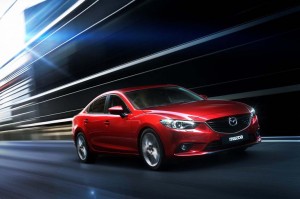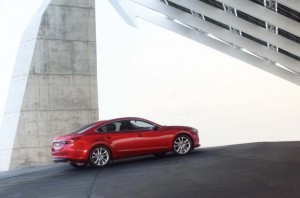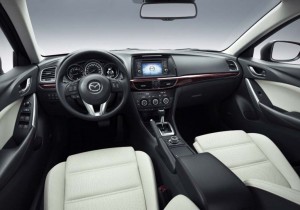The long-awaited new Mazda6 has made its debut – in Moscow. The Japanese automaker turned to the annual Russian car show to reveal the new sedan, the latest in its line-up to migrate to Mazda’s new SkyActiv technology.
The new 2013 Mazda6 will be entering a crowded field, what with makers including Honda, Ford, Chevrolet and Nissan all updating their own midsize entries. Mazda is hoping to stand out from the crowd by delivering a sedan that is bigger, roomier, more stylish – and notably more fuel-efficient – than the model it replaces.
Among the most distinctive new technologies introduced on the 2013 Mazda6, the sedan will use an ultracapacitor, rather than a battery, to help recapture energy that would normally be lost during braking or coasting.
The look of the new model is likely to be one of the big draws, however, styling chief Akira Tamatani proclaiming, “We have created a design in which the wild and dynamic expressions of motion artistically realize a powerful presence.”
The 2013 Mazda6 is heavily based upon the well-reviewed Takeri concept vehicle first revealed at the 2011 Tokyo Motor Show – which itself borrowed heavily from Mazda’s so-called Kodo, or Soul of Motion, design language.
The chrome accents framing a distinctive, black-out grille flow into the projector headlamps which, in turn, flow into sculpted front fenders designed to provide a sense of both elegance and muscularity. The roofline adds to the upscale feel with its rounded, almost coupe-like shape.
While the car on display in Moscow is “Russian-spec,” there are expected to be few changes, other than details like side marker lights, when the American version hits showrooms.
Overall length gains 1.6 inches. The front wheels have moved forward, reducing the overhang. The wheelbase is about four inches longer, adding significantly to cabin roominess. Even the trunk of the 2013 Mazda6 opens wider for easier access.
Mazda introduced its new SkyActiv technology with the launch of the next-generation Mazda3, earlier this year, taking things a step further with the all-new CX-5 crossover. The new 2013 Mazda6 adds several other features designed to enhanced performance, handling and fuel-economy.
While much of the focus is on Mazda’s new powertrain technology, SkyActiv is actually a suite of features, including the use of a new, lightweight platform. The maker has gone to great lengths to cut out mass, even modifying such seemingly insignificant parts as the fuel pump impeller and wheel lug nuts.
But there’s little doubt that the critical element is the new SkyActiv powertrain. Make that powertrains, as Mazda will offer two for the new Mazda6, including a 2.0-liter inline-four making 147 horsepower and 154 pound-feet of torque. The upgrade is a 2.5-liter four turning out 189 hp and 188 lb-ft. Buyers will have a choice of a 6-speed SkyActiv-Drive automatic or a 6-speed manual.
While Mazda is not confirming it yet, the maker is also reportedly planning to add a diesel to the engine line-up – one notably being used to power the Takeri concept that made the rounds of U.S. auto shows this year.
Final EPA mileage numbers have yet to be released but Mazda claims the gas-powered SkyActiv system will deliver diesel-level mileage, which would likely mean highway numbers in the high 30s or above for the 2.0-liter package. The 2.5-liter I-4 should also top 30.
The powertrain is paired with Mazda’s new i-ELOOP system, a very mild hybrid technology designed to recapture braking and coasting energy. But instead of piping that power back to a battery it is stored in a very high-tech ultracapacitor and used to help power the Mazda6’s various electronic systems.
The 2013 Mazda6 will feature a full complement of safety features, from Smart City Brake Support – which can automatically slow or stop the car if an obstacle is spotted while at low speeds – to backup sensors, rearview camera and lane departure warning.
Pricing is also not expected until closer to the U.S. launch this autumn.
Significantly, the new Mazda6 will now be imported from Japan. Mazda produced the last of the old midsize sedans at a plant in suburban Detroit last week. It is walking away from that long-time joint venture with Ford Motor Co. and bringing production back to its home market assembly line. Mazda eventually plans to add a new factory in Mexico but it will be used to produce smaller models, such as the Mazda3.
(For more on Mazda’s decision to abandon U.S. production, Click Here.)



